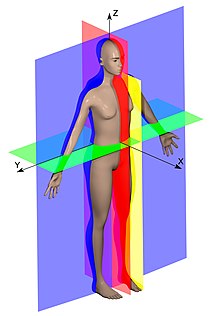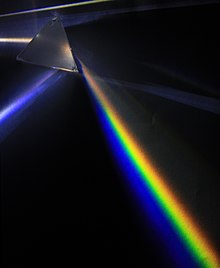Human vision and function/Part 1: Perception of objects/Complete the pre-reading for week 2
What does the visual system need for success?
[edit | edit source]At the end of this reading students will have considered:
- Descriptions of terms to explain orientation of structures within the body and Central Nervous system (CNS).
- Explanations and examples of how we can describe “colour”.
- Descriptions of structures within the eye (the rod and cone cells of the retina), that are sensitive to light of various wavelengths.
- Descriptions of processes beyond the rod and cone cells (dorsally/posteriorally), that enable the beginning of encoding of the form (shape) and colour of objects and scenes.
1. Describing positions within the human body and central nervous system
[edit | edit source]
The human body and nervous system is a 3-dimensional structure and is very difficult to represent using 2-dimensional images and drawings. As a result, it is customary to divide (or cut) the brain into one of 3 planes:
2. What is colour
[edit | edit source]
When we first consider colour vision we need to understand the properties of colour. Colour is electromagnetic radiation (energy) of particular wavelengths. A combination of all the wavelengths of the visible spectrum results in white light.
Visible light, for example, light from the sun, seems to us to be white. That is, if we view the whole of the visible spectrum it will appear white. It is, however, made up of different colours. Our eyes perceive this "continuum" of colours as white. It is only when one or more parts of this continuum is missing that we perceive colour. When these wavelengths pass from one medium through another, for example from air through a lens they are refracted (bent). The lengths of these waves are bent to different extents dependent on their wavelength. This can be seen in the colours produced by white light passing through a prism, or white light being refracted and reflected by water droplets and forming a rainbow, or by the many colours seen through a multi-faceted diamond.
Colour wavelengths range from 400 nanometres (nm) (violet/blue) to 800 nm (red). Blue wavelengths are the shortest, green are medium and red wavelengths are the longest. The types of colours mentioned above are those brought about and seen by the transmission of light. Transmitted colours can be mixed to produce many combinations. All possible combinations of colour can be made by mixing just the three; red, green and blue light. These are therefore called the primary colours for transmitted light.
When we view objects daily, however, the colours we see are of solid objects and the light is not transmitted. When light strikes a solid object it is reflected from the object and absorbed by cells in our eyes. Objects are coloured by pigments of solid, material, not of light. The predominant pigment of an object will be reflected to the eye, while all the other wavelengths making up the object will be absorbed. This process is described as subtractive mixing, as the absorbed wavelengths are subtracted from the final perceived colour. The reflected colour is the one that we appreciate as the colour of the object.
Pigment molecules are present in flowers, trees, animals, paints, dyes etc. Black objects have an absence of colour because all wavelengths are absorbed, while none are reflected.
Red objects absorb all wavelengths except the longer ones which are reflected by red pigment molecules and are appreciated as red. The light that has been absorbed by the objects is converted into other energy, such as infrared (heat). Thus, black jumpers on a bright day will absorb all the energy and reflect none (ideally). The primary colours of solid objects are red, blue and yellow.
Colour mixing
[edit | edit source]Mixing primary colours of pigments (the colours embedded within objects) is termed “Subtractive mixing” whilst mixing primary colours of light (the retinal cells are receptive to these wavelengths) is “Additive mixing”.Colour has the properties of hue, saturation and brightness. Hue is the pure colour itself, determined by the wavelength. Saturation is the amount that the hue is mixed with white light - the more white light, the less saturated is the colour, i.e. “pink” is a desaturated “red”. Brightness determines lighter and darker shades of the same hue.

3. How do we see colour?
[edit | edit source]In order for the eye to be able to respond to colours, receptors in the retina need to be sensitive to specific wavelengths of light.
There are three types of receptors for colour, within the cone cells of the retina. Red sensitive cones absorb long wavelengths, green sensitive cones absorb the medium wavelengths and blue sensitive cones absorb the shorter wavelengths. These are the photoreceptors.
Cone cells operate photopically (maximally sensitive in conditions of bright light) and are sensitive to light and colour. Rod cells operate scotopicically (maximally sensitive in conditions of dull light) and sensitive to changes in luminance, but not colour. Cone cells are sensitive for vision under bright illumination, as occurs during the day or when viewing with a bright artificial source. Rod cells are sensitive for vision under dim illuminations, as occurs at night.
Light enters the eye through the cornea and strikes the retinal cells. Notice that the Ganglion Cells (whose axons form the Optic Nerve) are actually in front of the Rods and Cones (photoreceptors).
4. Processes beyond the rod and cone cells
[edit | edit source]What are the processes beyond the rod and cone cells (dorsally/posteriorally), that enable the beginning of encoding of the form (shape) and colour of objects and scenes? Firstly you should consider the physical structure of the human retina. The photoreceptors convey their information via the bipolar & horizontal cells. The lateral (horizontal) spread of connections with the horizontal cells and the almost 1:1:1 relationship between the cones, bipolar cells & ganglion cells (at least at the fovea. The direct pathway is from photoreceptor to bipolar cell to ganglion cell. The indirect pathway is from photoreceptor to horizontal cell to bipolar cell to ganglion cell. This lateral transmission of information by horizontal cells enables inhibition of information that will enable definition of centre-surround receptive fields. This area of science is known as spatial encoding.